And no, I’m not kidding.
Bill deformities in birds are becoming increasingly common. I’ve documented a variety of species over the past 10 years or so exhibiting various shapes of anomalous bills, including the following:
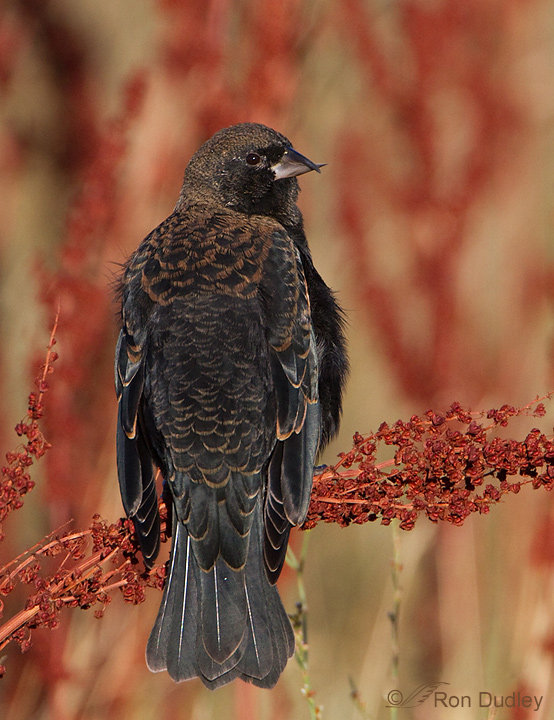
A Red-winged Blackbird with a crossed bill. I’ve also photographed a Sage Thrasher with a crossed bill.
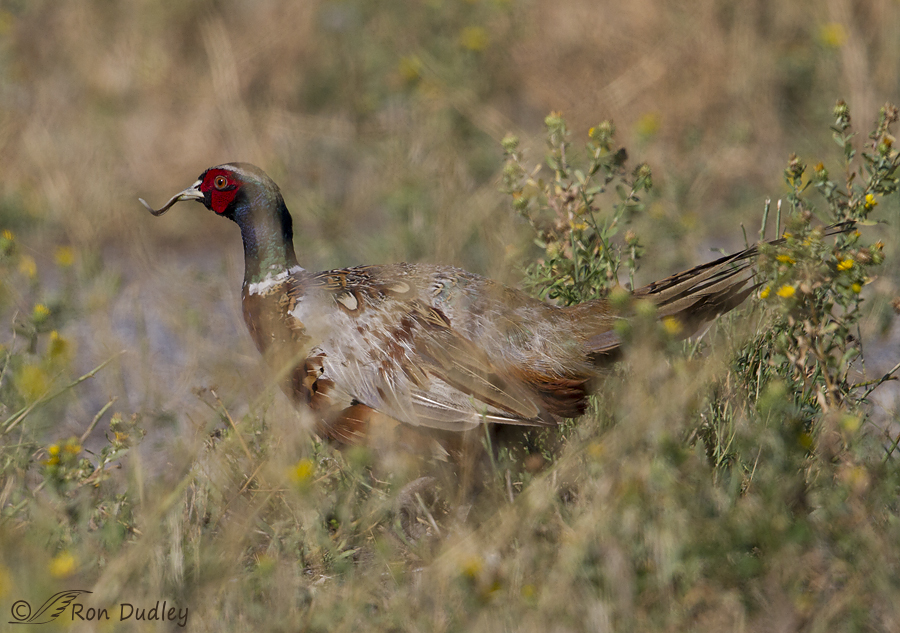
A male Ring-necked Pheasant with a long, corkscrew-shaped upper bill. I can’t imagine how this bird was able to feed and survive but he appeared to be perfectly healthy.
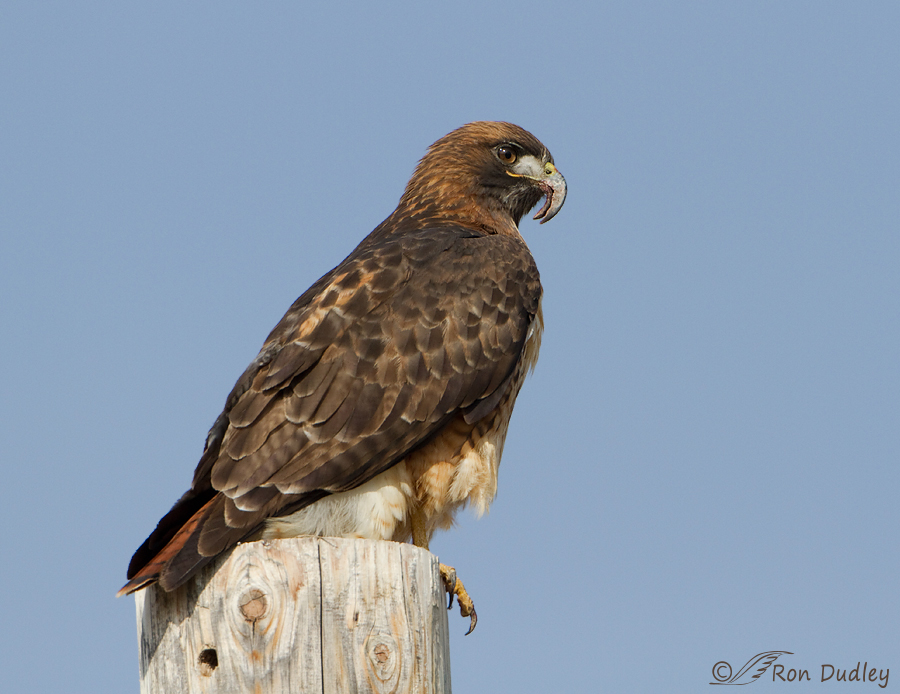
An adult Red-tailed Hawk with grossly overgrown upper and lower bills. This bird was hunting and feeding successfully and I watched as it consumed several voles. Its feeding technique was “different” but it was able to get the job done without too much trouble.
Several years ago this condition in raptors was called “long-billed hawk syndrome” by some authorities but more and more I’m seeing it referred to as “avian keratin disorder” as researchers learn more about it, especially in affected populations of Alaskan Black-capped Chickadees. A newly discovered virus – poecivirus – is the likely culprit in many cases.
Ok, with that extended prelude let’s cut to the chase.
Yesterday fellow bird photographer Dave Douglass contacted me through the contact page of my blog with the following question:
- “I’m also a bird photographer living in the mountains not far from Yosemite. A couple of mornings ago I shot a Red-tail and it had a….. double upper bill. I got a photo of it I’d like to show you for your opinion. I’m guessing that it has avian keratin disorder. Is there a way I can send you the file?”
To be honest I was a little skeptical at first that it was actually a “double upper bill” and thought it was more likely to be some form of AKD/long-billed hawk syndrome but I provided Dave my email address and he sent me some images of the hawk in question.
I was taken aback by what I saw in Dave’s photos.
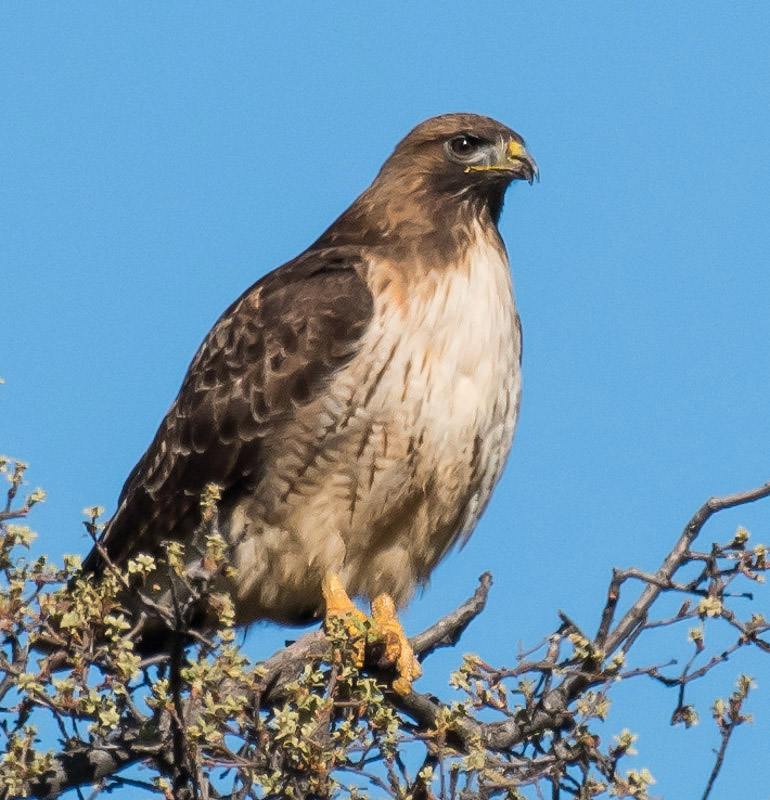
Copyright Dave Douglass, Image Used By Permission
The bird really does appear to have a double upper bill.
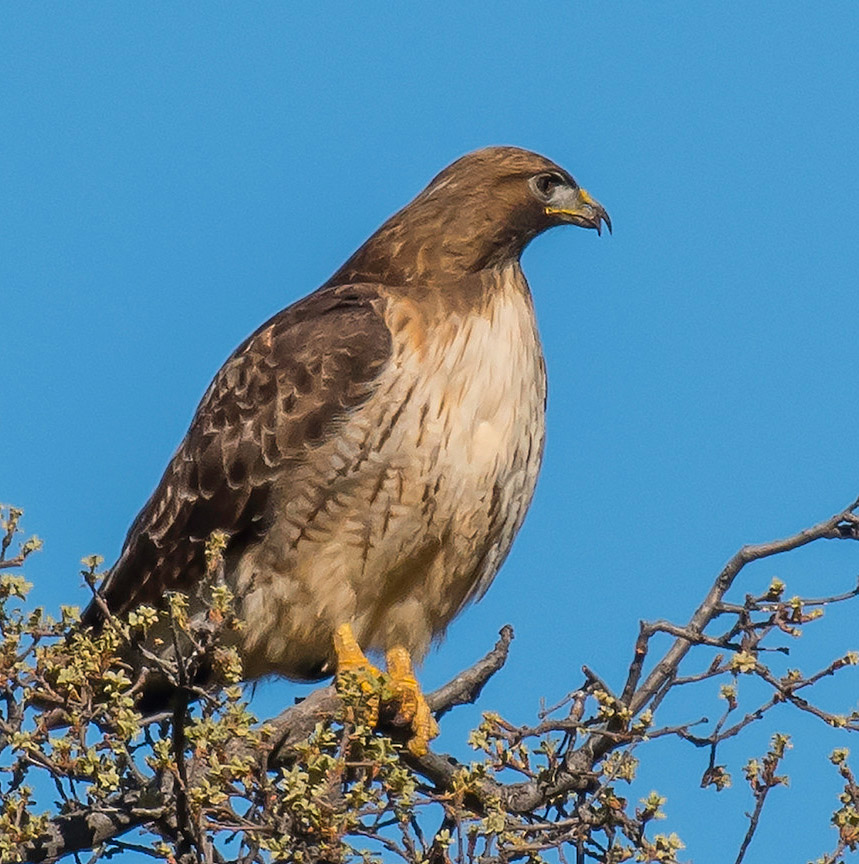
Copyright Dave Douglass, Image Used By Permission
One appears to be laying atop the other with at least some space between the two and only the top one appears to have a distinct cere.
Dave said these photos were taken 4 days ago (March 19, 2018) in the eastern Sierras of CA near Don Pedro Reservoir. The hawk “did not look unhealthy” and there was “nothing unusual in its flying ability”.
To my untrained eye this does not appear to be AKD or anything else caused by a virus or other environmental factors. Because the bird apparently has two “copies” of its upper bill I’m more suspicious of some kind of genetic anomaly but of course that’s largely just a shot in the dark by this long-retired biology and zoology teacher.
So I’m wondering if any of my readers, particularly among the falconers, rehabbers, researchers and raptor authorities who follow my blog, have any insight about what may be going on with this hawk.
Both Dave and I are consumed by curiosity so we thank you in advance for any feedback.
Ron
Notes:
- If anyone out there sees a bird with apparent AKD or other bill deformities I urge you to report it here. My good friend Jim DeWitt provided the link to me on Facebook.
- Some may be curious about why I’ve used the terms “upper and lower bills” instead of maxilla and mandible. As a biologist I’m engrained in maxilla and mandible but many “authorities” out there, including Sibley, refer to them as “upper mandible and lower mandible”. I never know which way to go so I spinelessly took the easy way out…


I think it is Dave’s responsibility to get more shots of this red tail. If we can alert more birders in that area (to the north, east and south) we might be able to track its movement, and be able to gain some more information on it.
I suppose trapping it is out of the question ???
Great work guys !
I drove down to where i spotted that Red-tail again yesterday morning hoping to see it again and maybe get a cleaner shot. No luck. Didn’t see it. I’ll keep looking.
I revisited where I saw this Red-tail this morning and never saw it. I’m thinking of going down again tomorrow as there’s a VERY active Osprey nest nearby with lots of hollering, fighting, displaying, and sticks getting added and taken away from the nest. We saw as many as 5 in the immediate vicinity of the nest at one time. Don’t mean to rob this thread. It just adds to my wanting to go back down there hunting for our star hawk.
Ron,
Thanks for posting that link to report birds with bill deformities. Back in February I photographed an American Dipper with crossed bills, the top bill being longer and hooked sharply down. I have been photographing Dippers at a Trout Hatchery since 2015 and this is the first I’ve seen it. There have been chicks every year, so perhaps this is a young bird. I’ve just submitted a report along with two photos.
Good for you for reporting it, John!
I agree with Laura Culley in that some birds and humans with disabilities and/or deformities somehow adapt and survive. I’m so glad to see that the birds you’ve shown look healthy.
Your blog is always eye opening about many topics. Your reader’s comments are always worth reading with their many insights.
Thank you, Ron
I appreciate your kind words, Alice. Thanks.
I am so glad to see that these birds appear healthy. Here we fairly regularly see sulphur crested cockatoos suffering (and they do suffer) from what is colloquially known as beak and feather disease . Their beaks grow and grow until they are unable to feed or groom. A heart-breaking sight. We have from time to time caught birds in the final stages of the disease and taken them to the RSPCA to have them put out of their suffering. And it breaks my soft heart to see them.
That looks like an absolutely horrible disease, EC!
It is. Really, really horrible.
Like the rest of the falconers here, my first instinct is to trap that bird and give it a good coping. However, I’d like a much better look at the structure of the upper beak where it intersects with the cere and nares. The good news is that like others have said, this bird looks healthy overall. I’d suspect that’s because the lower beak looks closer to normal and functional while the upper is out of the way and doesn’t interfere with the function of the lower in the bird feeding itself.
Bottom like is I’m always amazed at how critters (including many humans) adapt to their deformities/disabilities and make it work as best they can.
Thank you all for your contributions to this discussion! What a wonderful blog this is!!
Thank you, Laura.
Let me elaborate a little on the organochlorine exposure hypothesis. To repeat, my field is fisheries biology, not avian biology. I did research with the National Marine Fisheries Service and co-authored two papers on the effects of crude oil on marine food chains. The relevant information is that some petrochemical compounds are very persistent, are water-soluble, cause mutations and genetic aberrations at very low doses (parts per billion), and bioaccumulate up the food chain. That means that algae exposed to oil leaks or other sources of chlorinated hydrocarbons, like herbicide, fungicide, pesticide residues in water, take up the chemical compounds. The algae are ingested by bivalves such as clams, mussels, oysters, which accumulate and concentrate the chemical compounds in their flesh. They are ingested by fish, where the compounds are further concentrated, now in reproductive organs, liver, fatty tissue. In our lab, we found that in ppm, benzene, xylene, toluene, were water-soluble, bioaccumulated up the food chain in this manner, and damaged the reproductive organs of the fish we studied. If the bird beak matter were my problem, I’d do a literature search and ask the principals at Cornell, U Alaska, etc. A reasonable food chain for bird feeder creatures like chickadees would be non-organic bagged sunflower seeds, for example, grown with herbicides, pesticides, fungicides, then sold in hardware and garden supply stores and fed to chickadees. With regard to raptors, the ride up the food chain would go from water to fish, insects, thence to mice, rats, gophers, then up to raptors.
Martha, the process you describe sounds very similar to what used to happen to DDT (also an organochlorine) as it moved up the food chain, concentrating most in top predators.
Yes, that is the same pathway.
Inwish thise birds luck!!!
Wow! How bizarre. Thanks for the mystery, Dave. My first thought was an early injury, but I’m just an armchair aviophile. Glad all these birds seem healthy and happy.
Hi Ron, Another falconer’s opinion.
I have seen a Red Tail with what looked like two beaks side by side. It was the result of a car/hawk collision (the car won!) that split the hawk’s beak vertically. It appears that each half was trying to regrow into a new beak. Could that be what happened here with the split horizontal rather than vertical? Like my friend John, I have an almost irresistible urge to trap her and cope her beak back to normal, but my guess is that it will always be that way. She is looking good and able to eat, and preen. I expect she’ll live out her life just looking a little odd.
Can you do a really tight, high resolution crop of the beak and nares? The internet image pixelates too much to see the fine details, but it looks like a horizontal split might be a possibility.
Thanks, Mark. I was also hoping you’d add to the conversation too. You mention an interesting possibility.
If you’re talking about Dave’s bird I don’t have the high-res version of his photo so I can’t get any more detail.
Well, in 33 years of rehab experience and hundreds of red-tailed hawks, I’ve never seen anything like Dave’s bird. I’ve seen AVD in a few red-tails (and the one Ron shows above is classic (amazing that he could feed himself, Ron, and apparently preen – as his feathers look in good shape), yes; cross-billed blackbird chick, yes; cross-billed great blue heron, yes; a recent photo on the RaptorCare listserv that looked like an adult cross-billed bald eagle but was probably the result of an injury. As Mikal said, an injury to the growth plate of the beak might result in such an anomaly but what Ron and others have said about genetic mutations, viral or congenital, could maybe also do that – I’m no expert. I do think the red-tail population remains strong enough that in-breeding seems unlikely. Not really sure why I’m bothering to reply, as I clearly don’t have anything to offer beyond a mutual, mystified head-scratch! But thank you to both Dave and Ron for capturing and sharing these photos. Makes me want to share some of a poem by Mary Oliver, titled Messenger: “My work is loving the world … Let me keep my mind on what matters, which is my work, which is mostly standing still and learning to be astonished. …”
I appreciate you weighing in on this, Louise. I was hoping you would!
I beg to differ with your claim that you clearly didn’t have anything to offer. Just the fact that the condition exhibited by Dave’s bird is something you’ve never seen, with your vast experience and knowledge, is telling and useful in and of itself. Thank you!
Yeah, what Ron said!
In this case I think the easy way out is the best!
By the looks, and remember looks can be deceiving, the birds do look healthy in the pictures. I will be very interested in the results. I have always “felt” as a retired biology and environmental science teacher that something we are putting into the environment is affecting some genomes remembering that there is diversity in any population, so the effect would only be on some individuals. However, as I said I “felt” this, so I am very interested in what others/research have come up with.
Very interesting post Ron, many thanks.
“In this case I think the easy way out is the best”
That’s why I took it, Dick! I’m a little surprised by that apparent inconsistency in terminology.
I’m a little surprised by that apparent inconsistency in terminology.
As a rehabber, I’d wonder if this could be the regrowth after a beak injury, a crack from an impact injury for instance. Rather like our fingernails, the beak keeps growing for the bird’s entire lifetime. An injury might split the growth plate, eventually resulting in this weirdness. I”m amazed at the resiliency that wild ones sometimes exhibit.
Hmmm, hadn’t even considered that possibility, Mikal. Thank you.
Tell him to keep trying to get clearer pictures those red tails tend to hang out in same area he should be able to spot it again .. I have lots of red tails never seen anything like it …
Dave is seeing these comments, Marina.
From zugunruhe to bill deformities I’m loving learning something new from you .Until you zoom in they look healthy.
It will be interesting to hear everyone’s comments.
Have a great day
“Until you zoom in they look healthy”
Exactly, Diana. Makes one wonder how many others like this are “out there” because few birds are seen by the average person in good enough detail to even notice such things. High powered lenses come in handy for things like that.
My first hypothesis is parental exposure to organochlorines, which are mutagenic and teratogenic. See, for example, the Kesterson Reservoir event in California. Birds at Kesterson hatched with abnormalities – this doesn’t mean that organochlorine exposure only shows defects in hatched chicks. I did fisheries, not avian, biochemistry research, so I am not expert on this, but I do recognize similarity.
An interesting (and scary) possibility, Martha.
I will continue to look for this bird in hopes of getting some cleaner photos. Oh, and I don’t know if it matters but I gave Ron the wrong date for the sighting. I actually spotted it on the 19th. Fingers crossed.
Thanks for clearing that up, Dave. I’ve edited my text to include the correct date.
Ron your photo of the Redtail makes me want to trap it and cope that beak. I’m glad its learned to hunt around it,but it seems that it shows no sign of stopping.
Dave’s photo seems to be either a strange birth defect or as mentioned before an environmental defect. By the way its grown I suspect more a birth defect or even an obsorbed second yolk.The beak on the bottom seems normal in size and shape which leads me to believe the second was a gene issue. Thank you both for sharing these photos. Hope someone might have other ideas too.
It’s my guess that the defect in Dave’s hawk is genetic too, John. However some viruses can cause birds to express genetic traits so pinning it down to one or the other could become a little murky…
I have seen Crows & Pigeons with abnormalities but not this extent, usually feet & legs. As a cat breeder, I will not breed father to daughter or mother to son as that close breeding can be a disaster. For example: Organs on the outside including on the back, kittens with cleft pallet, more than 2 eyes etc. I am wondering if birds are becoming too interbred?
I don’t know for sure, Shirley but it would be my guess that interbreeding in wild bird populations wouldn’t usually be much of an issue.
Huh! VERY strange……… Glad Dave documented the extra upper bill – almost reminds me of a “unicorn”. Hopefully more insight is to come!
“Hopefully more insight is to come”
I sure hope so. My curiosity itch needs scratchin’.
wonderful shots Ron puzzeling.
charlotte
Thanks, Charlotte.
Thanks to you and to Dave for noting that these birds appear to be well-fed and otherwise healthy– the posts would have been distressing , otherwise– still disquieting, anyway….. my go-to
suspicion is usually the presence of residual radiation fall-out from the nuclear-testing years, but that wouldn’t be too likely in the region of the Sierra Nevadas,,,,,,,I’ll be interested to read what others in
your audience comment .
“I’ll be interested to read what others in your audience comment”
Me too, Kris. Me too!
The radiation was my husbands first thought also. He’s an “atomic” vet from the Korea era stationed down in the SW during all the testing then….